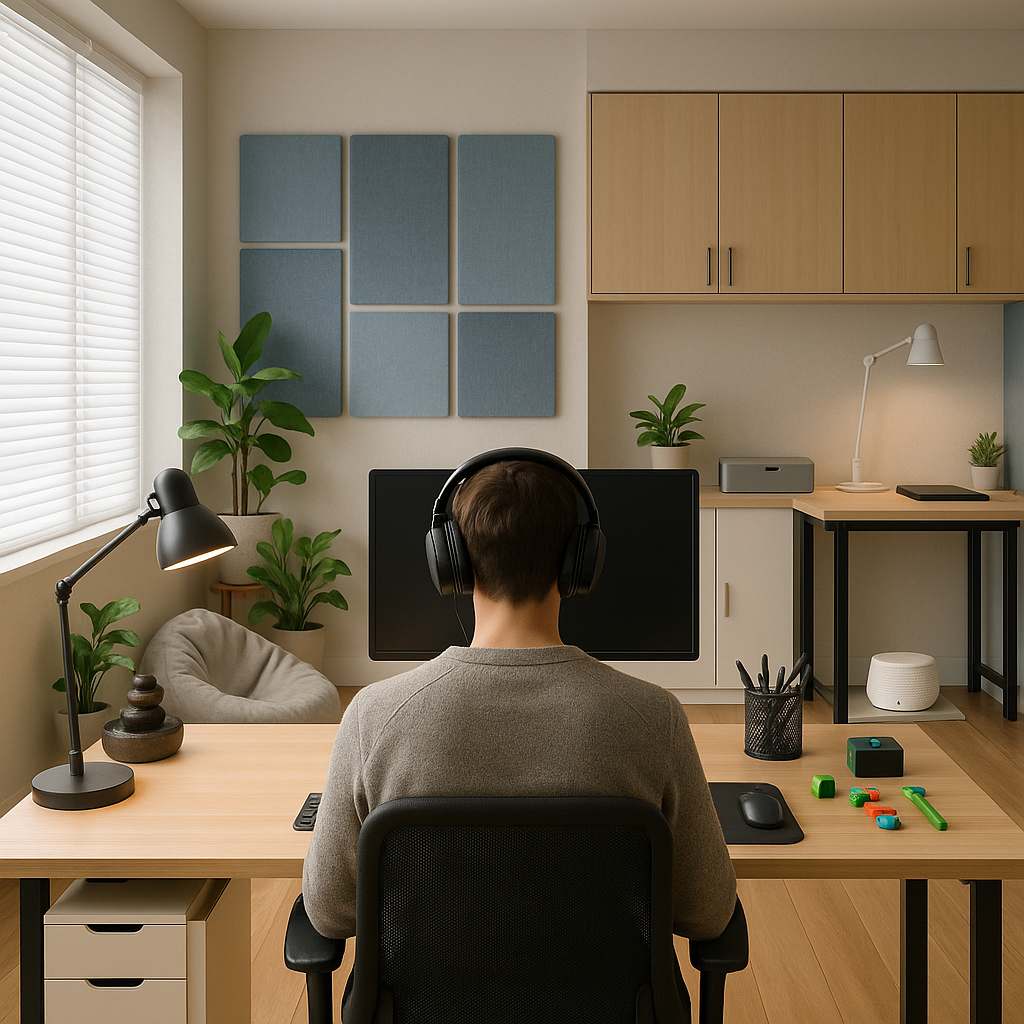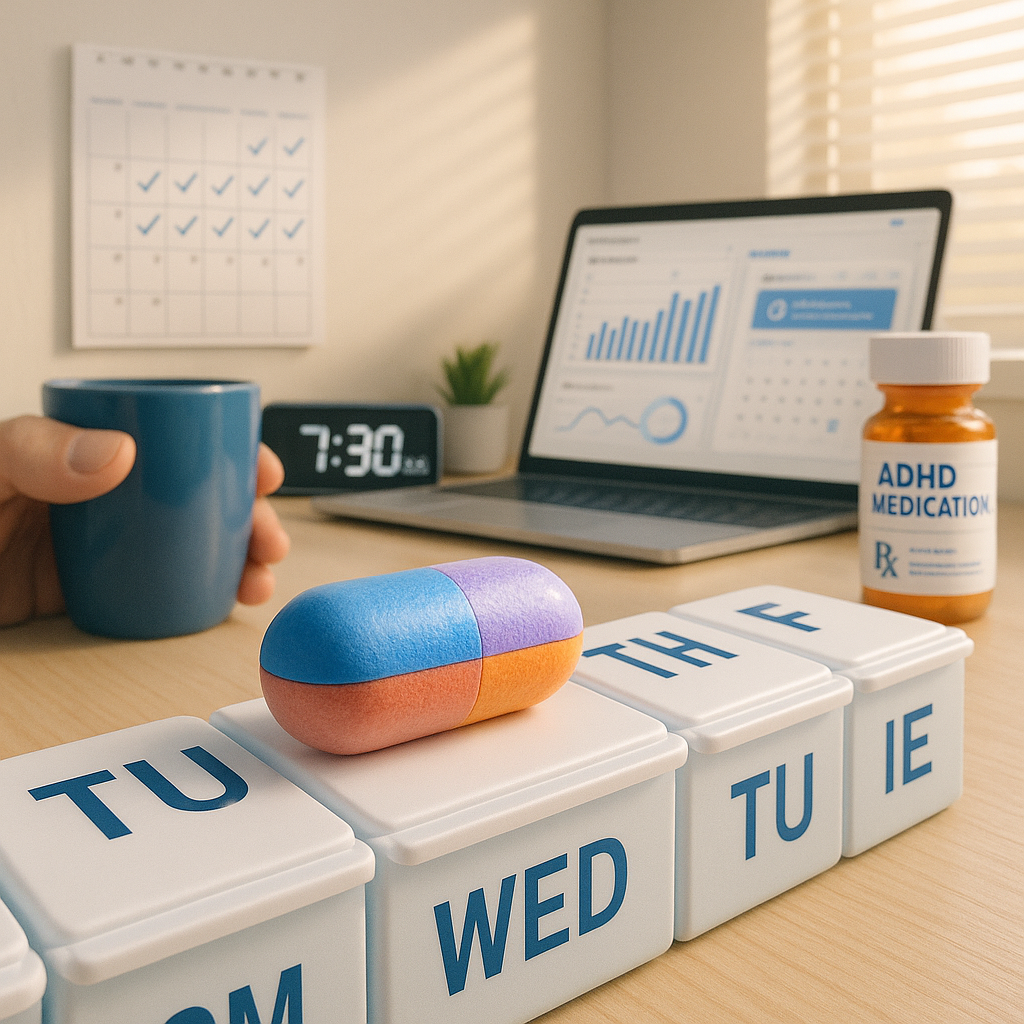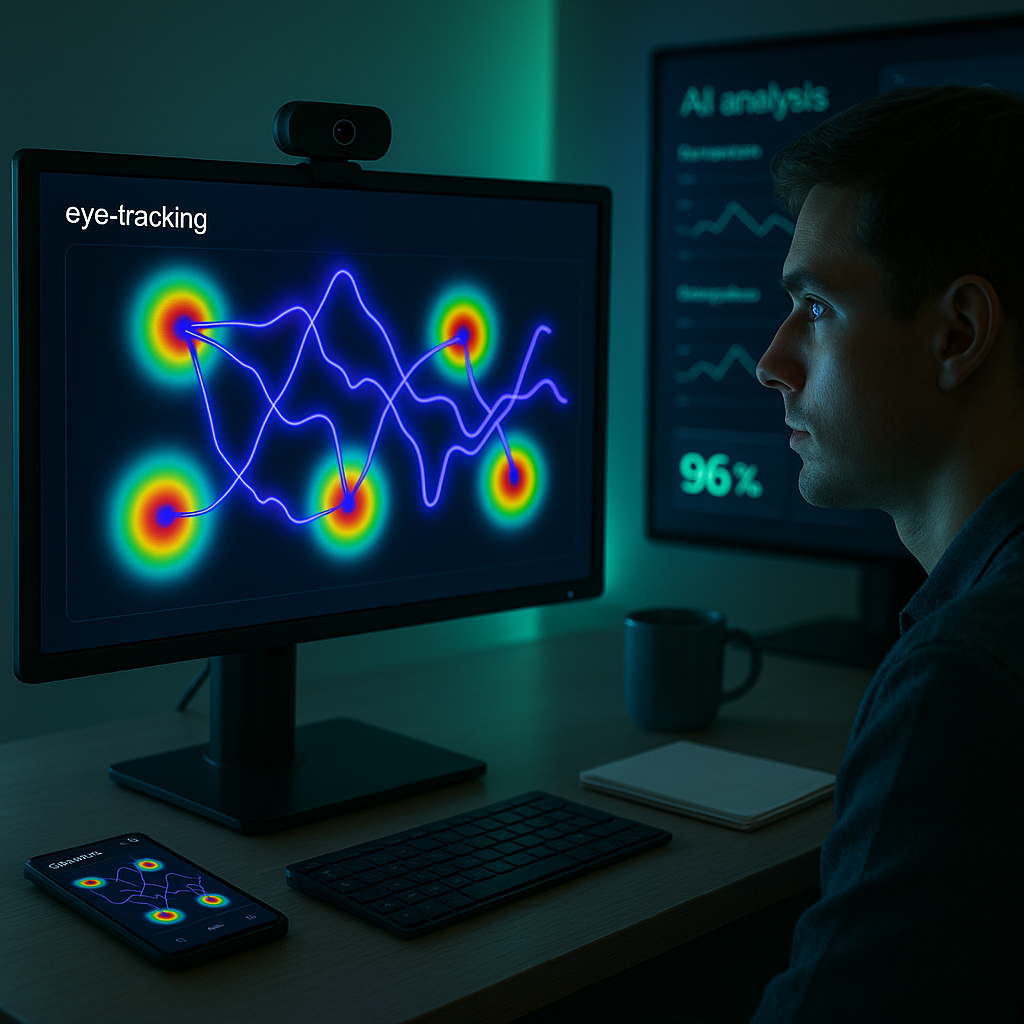Key Takeaways
Sensory overload is a daily reality for many people with ADHD, shaping how we work, think, and feel in our environments. By understanding the unique sensory triggers at play (from lighting and sound to clutter and temperature), we can actively design workspaces that boost focus while easing discomfort. Implementing neuroscience-backed strategies can help transform any space into an ADHD-friendly haven that supports productivity, creativity, and wellbeing.
-
Master the art of sensory zoning for dynamic needs: Go beyond simply reducing triggers. Create distinct zones with varying sensory qualities, so you can transition between high-energy, focused, and relaxation spaces as your sensitivities fluctuate throughout the day. For example, designate one area for deep work and another for movement breaks or creative brainstorming.
-
Adjust lighting to empower your brain without overstimulation: Opt for dimmable bulbs, indirect fixtures, and maximize natural light to minimize harsh glare and visual fatigue. Using adjustable options gives you flexibility to match lighting with your mood and energy level, enhancing both comfort and alertness.
-
Combat noise chaos with smart sound controls: Employ sound-dampening materials, white noise machines, or noise-canceling headphones to craft an acoustic environment that supports deep work or offers a soothing retreat. These solutions are especially valuable in open offices, shared spaces, educational settings, and at home.
-
Declutter for visual calm, not just aesthetics: Maintain minimal work surfaces and organize supplies with closed storage solutions. By reducing visual “static,” your brain can focus with greater clarity, lowering the risk of overwhelm and distraction.
-
Integrate nature to self-regulate on autopilot: Introduce small plants, natural textures, or flowing water sounds to provide gentle, positive sensory input. Evidence shows that these elements not only stabilize energy and stress but also enhance creativity and mood in workplaces, classrooms, and healthcare environments.
-
Design affordable hacks before big renovations: Use budget-friendly upgrades like portable screens, area rugs, soft furnishings, and peel-and-stick light-diffusing films to rapidly improve the sensory experience of any room. These simple changes can have an immediate and dramatic impact.
-
Build a personal sensory toolkit for on-demand comfort: Keep fidget tools, weighted lap pads, calming scents, or noise-masking earbuds at your desk. Taking micro-breaks and self-regulating input boosts both comfort and productivity, whether you’re working, studying, or managing daily routines.
By reframing workspace design as a flexible, evolving toolkit that adapts to your brain’s changing needs, you’ll move beyond one-size-fits-all advice. Instead, you’ll create an environment that truly works for you. In the following sections, we’ll dive deeper into each strategy, equipping you with detailed guides and real-world examples from diverse industries to help you transform your workspace immediately.
Introduction
For many people with ADHD, sensory overload is not a minor inconvenience. It can hijack focus, drain energy, and turn daily work into an uphill battle. Everyday occurrences like a fluorescent hum, scattered papers, or a distracting playlist can quickly spiral your mind from clarity to chaos.
Yet, hope lies in a thoughtful approach to environmental design. By tuning into your unique sensory triggers and adopting evidence-based hacks (such as optimizing lighting, controlling sound, and staying organized), you can reclaim control of your workspace. This transition is about more than comfort. It’s about unlocking your ability to concentrate, create, and succeed with less struggle.
Let’s unpack a practical toolkit of workspace hacks, moving beyond generic advice, to empower you in creating a space where your neurodivergent brain can settle and thrive.
Understanding Sensory Triggers in the ADHD Workspace
Every brain processes sensory input differently, but for people with ADHD, heightened sensitivity to the surrounding environment can be especially pronounced. When lighting, noise, temperature, or clutter become overwhelming, it impacts not just comfort, but directly affects productivity and wellbeing.
Common workspace triggers include:
- Fluorescent lighting: Can cause harsh glare, subtle flicker, and headaches.
- Background conversations: Difficult to filter out, breaking focus.
- Visual clutter: Constantly distracts, increasing cognitive load.
- Temperature swings: Impact mood and concentration.
- Strong scents: From cleaning supplies or perfumes, can be distracting or even distressing.
The first step toward improvement is self-awareness. Keeping a simple “sensory diary” for a week (jotting down moments of overwhelm and the associated environmental factors) helps identify your unique triggers across work, home, educational, and social settings. This personalized insight sets the foundation for meaningful change.
Mastering Sensory Zoning: Your Space, Your Rules
Once you’ve identified your sensory triggers, the next step is to proactively shape your environment. Sensory zoning empowers you to divide your workspace into distinct areas, each tailored to specific sensory needs and tasks. This approach supports shifting energy levels and fosters greater adaptability, especially as requirements fluctuate during the day.
Creating Your Zones
-
Deep Focus Zone
-
Reduce visual stimuli with minimal décor and cleared desk surfaces.
-
Dampened sound with carpets, panels, or headphones.
-
Controlled, adjustable lighting to minimize eye strain.
-
Positioned far from high-traffic or noisy areas.
-
Active Work Zone
-
Moderate stimulation with bolder colors or dynamic décor.
-
Adjustable lighting (consider daylight bulbs for alertness).
-
Organized access to tools, papers, and supplies for efficiency.
-
Incorporate a standing desk or balance board for movement.
-
Reset Zone
-
Cozy seating with soft textures or a bean bag chair.
-
Incorporate live plants or natural views for a calming vibe.
-
Include calming sensory tools (e.g., stress balls, aromatherapy).
-
Intended for quick, restorative breaks to reset the mind.
Your available space will determine how elaborate your zones are. They may be separate rooms, different corners of an office, or simply defined sections on a large desk. In educational, healthcare, or even retail settings, sensory zoning can help users switch environments as needs change throughout the day.
Lighting Solutions for Sensory Comfort
Lighting is a powerful tool in reducing overwhelm and improving focus. The right lighting setup can banish headaches and boost cognitive performance across professional, educational, legal, or healthcare settings.
Natural Light Management
- Use blinds or cellular shades for fine-tuned control over glare and brightness.
- Arrange the desk at a 90-degree angle to windows to avoid direct light on screens and eyes.
- Anti-glare screens improve device comfort, especially for extended computer use.
- Light-directing window films soften incoming sunlight while maintaining brightness.
Artificial Light Solutions
- Task lighting: Opt for adjustable LED desk lamps with dimming features.
- Ambient lighting: Add floor lamps or sconces that diffuse light gently.
- Color temperature: Choose bulbs that allow color range adjustments (from energizing cool whites to relaxing warm hues, typically 2700K-5000K).
- Smart lighting: App-controlled bulbs adapt to your schedule, automatically shifting brightness for morning focus, afternoon energy, or evening calm.
These lighting strategies are cost-effective and easy to implement at home, in offices, classrooms, clinics, or small businesses.
Sound Control Strategies
Managing sound is crucial for preventing distractions and sensory overload, particularly in spaces where background noise is inevitable (e.g., shared offices, classrooms, busy retail environments, or healthcare clinics).
Physical Sound Management
- Install affordable sound-absorbing panels or foam tiles on walls and ceilings.
- Place door sweeps, weather stripping, or draft stoppers to reduce noise leakage.
- Hang heavy curtains or acoustic drapes over windows and hard surfaces.
- Use rubber pads under furniture to minimize scraping and bumping sounds.
Electronic Solutions
- White noise machines: Compact devices with multiple sound profiles mask unpredictable noise. Recommended option: LectroFan Classic.
- Noise-canceling headphones: From premium models like Sony WH-1000XM4 to budget-friendly alternatives, these are essential in noisy environments.
- Sound masking systems: Particularly useful in larger offices or clinics where privacy and concentration are priorities.
- Smart home integration: Use automated routines for background soundscapes to match work cycles and energy.
Educational environments, coworking spaces, and healthcare facilities can all benefit from layered sound control for inclusivity and productivity.
Visual Organization and Clutter Control
Visual clutter is both a distraction and a source of stress for many neurodivergent individuals. Tidy, visually organized spaces foster better concentration whether you’re working, studying, or engaging with clients.
Immediate Organization Solutions
- Use matching storage containers in soothing colors to avoid visual noise.
- Implement closed storage (drawers, cabinets, boxes with lids) to keep rarely used items out of sight.
- Organize items by category and zone for intuitive access.
- Apply color coding sparingly. Stick to simple, harmonious palettes to avoid sensory overload.
Long-term Management Strategies
- Build a daily five-minute tidy-up habit to reset the space.
- Establish “landing zones” for incoming materials, mail, or paperwork.
- Maximize vertical space with wall-mounted shelves, pegboards, or hooks.
- Maintain a minimalist desk. Use trays or cable organizers to corral loose items.
These techniques apply anywhere from home offices to classrooms, legal firms, medical exam rooms, and even retail stores.
Integrating Natural Elements
Incorporating nature into your workspace provides more than visual appeal. Research shows it calms the nervous system, increases focus, and stabilizes mood. This makes it a crucial component across industries from finance and healthcare to education and marketing.
- Plants: Choose air-purifying, low-maintenance types like snake plants, pothos, or ZZ plants for offices or waiting rooms.
- Natural materials: Use wood, bamboo, or stone in furniture, accessories, or décor for tactile comfort.
- Water features: Small fountains or water walls create soothing white noise, reducing stress.
- Nature views: Orient desks or seating to face windows, even in urban settings, to gain the benefits of natural light and outdoor scenery.
Bringing nature indoors offers easy wins for emotional regulation and sustained productivity.
Building Your Personal Sensory Toolkit
No single workspace hack fits everyone. Having a personalized sensory toolkit lets you adjust on demand, managing fluctuating stress and stimulation levels in any context (work, school, home, or public spaces).
Essential Tools to Consider
- Fidget items (spinners, cubes, putty) tailored to preferred tactile input.
- Light-blocking glasses or visors for screen-heavy days.
- Noise-canceling earbuds or discreet earplugs.
- Weighted lap pads or blankets to provide calming pressure.
- Aromatherapy sticks or roll-ons, provided strong scents are not a trigger.
Emergency Toolkit Items
- Spare headphones and backup chargers.
- Portable white noise machines or downloadable sound apps.
- Blue light-filtering glasses for extended digital tasks.
- Stress-relief toys or calming textures.
- Comfort objects (photos, small plushies, favorite pens) unique to you.
Rotate or refresh your toolkit seasonally or as project demands change to keep your strategies current and effective.
Conclusion
Transforming your workspace into a sanctuary for the ADHD mind begins with recognizing your sensory triggers, then proactively designing each element to transform challenges into assets. By embracing strategies like sensory zoning, adaptive lighting, layered sound management, visual organization, and integration of natural elements, you create environments where focus, creativity, and comfort flourish side by side. Building a personal sensory toolkit ensures flexibility, empowering you to adapt in real time rather than working against your strengths.
This journey isn’t about achieving perfection; it’s about constructing a system that evolves with your unique rhythms (a system designed for real life and real brains). As you tailor your workspace to support your neurodivergent mind, you pave the way for higher productivity, deeper wellbeing, and greater self-acceptance. The next step is yours. Which adjustments can you make today to help your workspace amplify your “not broken, but brilliant” mind and set the stage for your best work ahead? Looking forward, those who continually adapt their environments and embrace their sensory needs will be the ones who turn adversity into advantage. Thriving isn’t despite neurodivergence, but because of it.





Leave a Reply